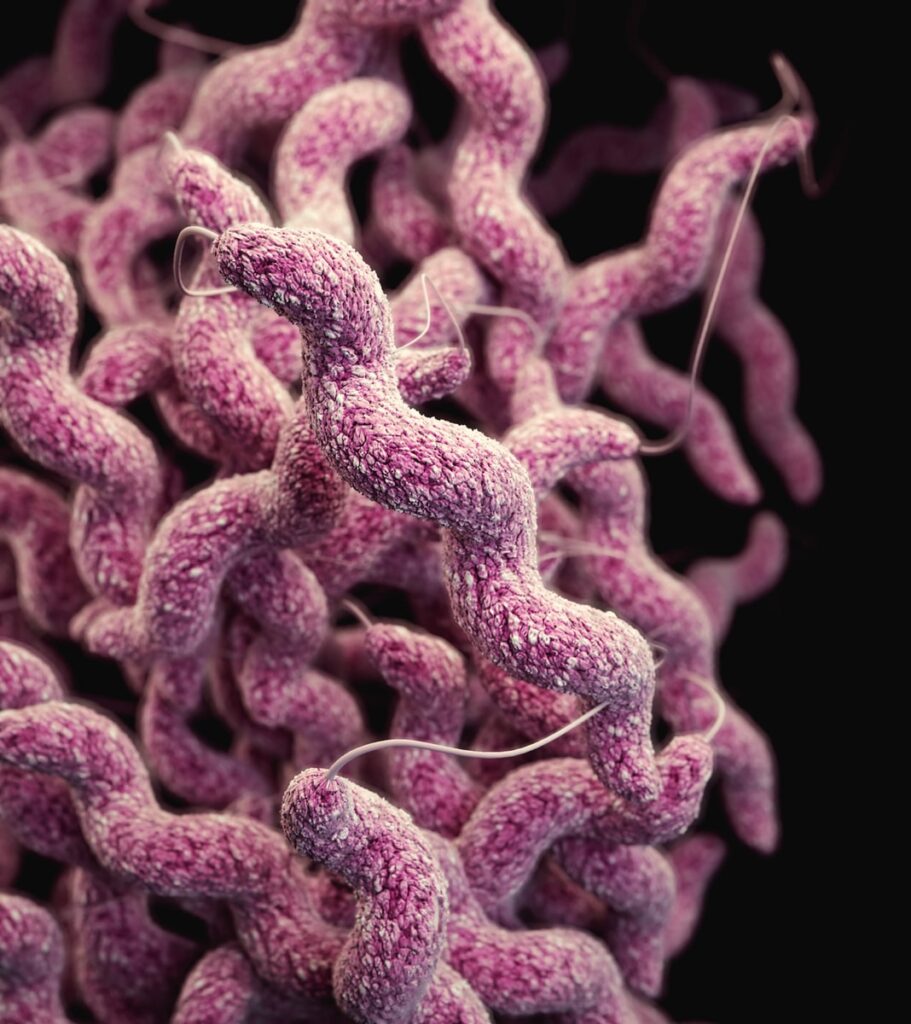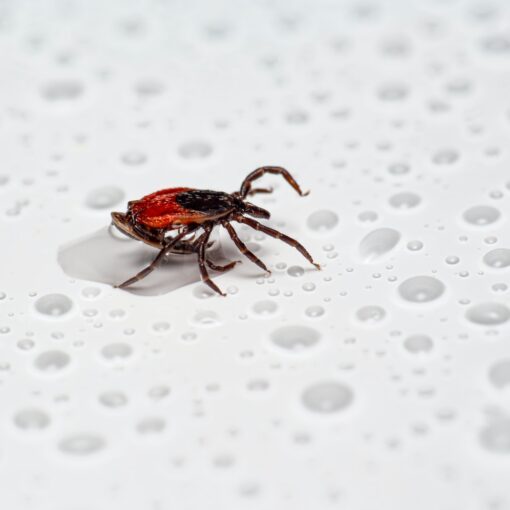Page Menu
Campylobacteriosis is a gastrointestinal infection caused by the bacterium Campylobacter jejuni. While this bacterium is not typically life-threatening, it can lead to severe complications such as Guillain-Barré syndrome and reactive arthritis. Treatment usually consists of antibiotics.
Key Concepts and Top Takeaways
– Practice good hygiene: Wash hands thoroughly before handling food and after using the bathroom.
– Cook meat properly: Ensure poultry and meat are cooked to safe internal temperatures.
– Avoid cross-contamination: Use separate cutting boards for raw meat and other foods.
– Drink safe water: Only consume treated or bottled water, especially when traveling.
– Store food correctly: Refrigerate leftovers promptly to prevent bacterial growth.
– Be cautious with dairy: Consume only pasteurized milk and dairy products.
– Know symptoms: Watch for diarrhea, fever, and abdominal cramps as signs of infection.
– Stay hydrated: Drink plenty of fluids if experiencing diarrhea to avoid dehydration.
– Seek medical help: Consult a doctor if symptoms persist or worsen over time.
– Educate yourself on outbreaks: Stay informed about local food safety recalls and warnings.
Please Note: This post may contain affiliate links. If you click one of them, we may receive a commission at no extra cost to you. As an Amazon Associate, I earn from qualifying purchases.

It can be found in raw and undercooked chicken, as well as other foods. Some symptoms of campylobacteriosis include stomach cramps, diarrhea, fever, and nausea. The most common complication is Guillain-Barré syndrome, which is a nerve disorder that can cause paralysis or numbness. Most people who come into contact with this infection typically improve within 5 days, and it can be treated with antibiotics like azithromycin.
Campylobacteriosis is a bacterial infection that can be contracted through consumption of contaminated food and water. It is the second most common cause of bacterial gastroenteritis in the US, especially among children. If untreated, Campylobacteriosis can lead to severe dehydration and may even require hospitalization.
This infectious disease is caused by Campylobacter bacteria. The illness usually starts with diarrhea and stomach cramps, followed by other symptoms depending on the individual. Symptoms may include fever, nausea, vomiting, headache, muscle pains, severe abdominal pain and tenderness, dizziness, or a rash. Symptoms can last anywhere from 3 days to 3 weeks. It is transmitted to humans through contact with infected animals, as well as ingestion of contaminated foods or water.
Campylobacteriosis is a foodborne illness that can be caused by eating undercooked poultry, handling raw chicken, or drinking unpasteurized milk. It is one of the most common causes of diarrhea in the United States and can cause fever and stomach pain. Antibiotics are prescribed for this disease and recovery usually takes 2-10 days. There is no vaccine for Campylobacteriosis, but it can be prevented by cooking poultry thoroughly or drinking pasteurized milk.
Symptoms of Campylobacteriosis
Campylobacteriosis is a gastrointestinal illness that can show symptoms of diarrhea, vomiting, nausea, fever, and headache. It can be caused by eating undercooked poultry or eggs contaminated with the bacteria Campylobacter. The symptoms typically last from 2-10 days and often resolve without treatment. However, for those who have a compromised immune system or gastrointestinal issues such as Crohn's disease, treatment may be necessary to avoid complications potentially leading to hospitalization.
Itchy, painful stomach cramps are a common symptom of Campylobacteriosis. Campylobacteriosis is a bacterial disease that can cause diarrhea, stomach cramps, and fever up to 2-3 weeks after being exposed. The incubation period for Campylobacteriosis is from 2-5 days, with the most likely time being from 3-4 days. Treatment is generally supportive with fluids and pain medications.
Campylobacteriosis, or campylobacter enteritis, is a bacterial infection that causes stomach cramps and diarrhea. Most people infected with Campylobacter can get better without any treatment in about 10 days. Symptoms of this infection include fever, diarrhea, abdominal pain and cramping, nausea, vomiting and headache.
When a person becomes infected with Campylobacter, they often experience diarrhea and abdominal pain, which may be accompanied by nausea and vomiting. Sometimes the infection can lead to weight loss from anorexia from early on in the course of the disease.
Campylobacteriosis is a bacterial infection that can spread from animals to people. The symptoms of Campylobacteriosis may include fever, chills, headache, muscle pain, and diarrhea. The infection usually occurs in the intestines but can also affect other parts of the body.
Fever is one of the symptoms of Campylobacteriosis. Other symptoms include headache, muscle pain, diarrhea, and chills.
The human body is continually fighting off microscopic invaders and infectious diseases. Sometimes, the immune system can't fight off viruses and bacteria alone, and the body becomes infected. When this happens, fever is often a symptom of campylobacteriosis, an infection caused by the Campylobacter bacterium that usually causes diarrhea, vomiting, and abdominal pain. The condition is typically not life-threatening unless there are other underlying medical reasons such as heart disease or cancer.
Nausea is a common symptom of many viral, bacterial, and parasitic infections. In some cases, nausea may be a tell-tale sign of an infection caused by the bacteria Campylobacter jejuni. This bacterium is most often found in raw or undercooked poultry or unpasteurized dairy products.
Nausea is one of the most common symptoms of Campylobacteriosis. These bacteria are contracted from eating undercooked chicken, drinking unpasteurized milk, or coming into contact with infected feces. The severity may vary from person to person, but it is often accompanied by fever, muscle pain, diarrhea, bloody stools, and even death in some cases. Treatment may include antibiotics or anti-nausea medication to help with dehydration.
Campylobacteriosis is a bacterial infection affecting the gastrointestinal tract. It is typically acquired from food or water contaminated by feces from infected animals, regardless of how it is consumed. Symptoms include fever, diarrhea and vomiting which can last anywhere from a few days to a week. In extreme cases, campylobacteriosis can lead to hemolytic uremic syndrome, an illness that causes severe kidney failure and can be fatal.
Campylobacteriosis is a bacterial infection that causes vomiting and diarrhea. Often, individuals suffering from Campylobacteriosis do not develop any other symptoms beyond the aforementioned ones.
Campylobacteriosis often manifests as a mild gastrointestinal illness, but some cases can progress to serious complications such as inflammation of the brain and spine, or life-threatening kidney infections. These symptoms may sometimes mimic those of different illnesses such as migraine or cluster headaches, making diagnosis difficult or delayed. It is important for doctors to recognize that Campylobacteriosis should be considered in patients with these symptoms who have had contact with sick birds, especially poultry.
Campylobacteriosis is a bacterial infection that can be contracted by barfing or pooping in the water. Even if you are not swimming, cook with contaminated water, or left unwashed dishes overnight on your counter, there are ways for you to contract Campylobacteriosis. A headache is one of the most common symptoms of Campylobacteriosis and can follow just hours after infection.
Sometimes when we think of an infection, we automatically think of that gross bump or wound that is the site of the infection. We don't often think about how our various systems can be infected and cause problems when they're not necessarily in a place where we would like to see them.
The most common symptom of Campylobacteriosis is muscle pain, which usually occurs about 30 days after exposure to the bacteria. The bacteria are most commonly found in raw or undercooked chicken, so consumers should be careful to cook chicken thoroughly before eating. If you experience these symptoms, and you consumed raw chicken, see your doctor immediately.
The muscle pains that a person may experience as a symptom of Campylobacteriosis are most likely due to the inflammation of the muscles. The pain can be felt in either or both sides of your abdomen, which is where the most common site for infection with Campylobacter is. The bacteria get into the body through contaminated food or water, most often by ingestion.
Causes of Campylobacteriosis
Campylobacteriosis is a bacterial infection caused by Campylobacter jejuni. The bacteria are commonly found in raw or undercooked poultry, unpasteurized milk, untreated water, and other foods that have been exposed to fecal matter. More than 270,000 people are diagnosed with campylobacteriosis each year. Chicken is the most frequent source of the bacteria, even though it is responsible for only 5% of reported cases.
Campylobacteriosis is a bacterial infection that causes diarrhea, vomiting, and fever. It can be spread through contact with poultry or other animal feces. The bacteria are often found in raw milk and untreated water. It is most often seen in children under five years old. The disease can last up to two weeks if not treated properly with antibiotics.
We are just beginning to understand the causes of Campylobacteriosis due to its many sources.
Risk Factors for Campylobacteriosis
Campylobacteriosis is a bacterial infection which is most often contracted through ingestion of uncooked meat, vegetables, or water contaminated with the bacteria. Symptoms include diarrhea, cramping, fever, and vomiting. Campylobacteriosis can be treated with antibiotics; however, dehydration is the most common complication of untreated campylobacteriosis.
Campylobacteriosis is a type of foodborne illness that causes diarrhea and vomiting. It is caused by eating raw or undercooked poultry, unpasteurized milk, or contaminated water sources. These are some risk factors for contracting campylobacteriosis: Eating raw or undercooked poultry, drinking unpasteurized milk, and exposure to contaminated water sources. To avoid contracting campylobacteriosis, cook meat thoroughly and drink only pasteurized milk.
Campylobacteriosis is a foodborne illness that most often occurs in the summer due to increased exposure to undercooked or raw chicken. The disease is most common in children, the elderly, obese individuals, and those with compromised immune systems. Campylobacteriosis can lead to debilitating symptoms including nausea, vomiting, abdominal pain, fever, headache, muscle pain, chills and diarrhea.
Complications From Campylobacteriosis
Campylobacteriosis is a common bacterial infection, and most people who come in contact with it will recover without any complications. Most cases of campylobacteriosis disappear on their own within 10 days, with or without treatment. However, in some cases the condition can become severe, requiring hospitalization for severe diarrhea, dehydration, or other complications.
Campylobacteriosis is a common foodborne illness that often presents with diarrhea and abdominal pain. It is often contracted from raw chicken but can also be passed through contact with water contaminated by animal feces. The most serious complications of Campylobacteriosis are Guillain-Barré syndrome, Reiter's syndrome, and sympathetic ophthalmia.
The Centers for Disease Control and Prevention (CDC) estimates that campylobacteriosis is the third most common foodborne illness in the United States. Campylobacteriosis is a bacterial infection caused by exposure to infected animal feces, contaminated water or unpasteurized milk. In rare cases, it can be spread from person-to-person contact as well as from person-to-animal contact.
In recent years, cases of Guillain-Barré syndrome have been appearing in the United States in much greater numbers than before. This is due to a foodborne illness known as Campylobacteriosis. In many cases, the infection reaches the central nervous system and causes Guillain-Barré syndrome. Although this disease has a minority occurrence rate, it can be fatal when it does strike.
Over 4 million people suffer from Guillain-Barré syndrome (GBS) each year. GBS is caused by an infection with Campylobacter, a bacterium found in raw and undercooked poultry and meat. The symptoms of GBS include weakness, tingling or numbness of the extremities and joints, facial paralysis, and difficulty swallowing or breathing. In severe cases, GBS can affect the respiratory system and lead to death.
Campylobacteriosis is a foodborne illness that can lead to Guillain-Barré syndrome. The link between the two has been shown in research, but not all cases of Campylobacteriosis have resulted in GBS. Campylobacteriosis is estimated to affect 1 in 3 people every year, with an average of about 14 cases per 100,000 people.
Campylobacteriosis is one of the most common bacterial food-borne illnesses in North America. It's caused by the bacteria Campylobacter jejuni, which is found in raw or undercooked poultry and other meat products. Symptoms vary from person to person but may include abdominal cramps and pain, diarrhea, nausea, headache and fever. If untreated, it can lead to short-term complications like reactive arthritis.
Reactive arthritis can arise as a complication of Campylobacteriosis, the infection most commonly caused by eating raw or undercooked poultry or other meat products, including dairy products. An individual with reactive arthritis is at risk for disability, which may last up to 10 years.
Symptoms can include nausea, vomiting, diarrhea, and abdominal cramps. If untreated, complications can result, including gastroenteritis and reactive arthritis. While antibiotics are needed for treatment of campylobacteriosis, these medications may not be necessary for treatment of gastroenteritis or reactive arthritis.
Caused by bacteria Campylobacter, Campylobacteriosis is a difficult-to-diagnose disease that can be painful and severely disrupt the digestive process. The first two days are typically characterized by diarrhea, vomiting, abdominal pain, and fever. An individual's symptoms may last up to ten days before they subside on their own. While the infection clears on its own for most individuals, some complications can arise.
Campylobacteriosis is a bacterial infection that causes diarrhea and abdominal cramps. While most people recover without any treatment, in some cases the infection can lead to complications such as severe dehydration. If not treated, dehydration can result in serious problems such as seizures, kidney damage, and even death.
Campylobacteriosis is an infection caused by the Campylobacter bacteria. The most common symptoms are diarrhea, pain in the abdomen, vomiting, and fever. It is typically treated with antibiotics. However, severe dehydration can be a complication of Campylobacteriosis.
Treatment for Campylobacteriosis
Campylobacteriosis is a minor infection that usually takes two to three weeks to clear up. Symptoms of campylobacteriosis may include fever, diarrhea, vomiting, and pain in the abdomen. A person can get this condition from consuming food or drinking water that has been contaminated with the bacteria.
If you have these symptoms, be sure to see a doctor, as an antibiotic treatment will usually need to be completed in order for the illness to go away.
Typically, antibiotics are not needed for mild cases, but if the condition progresses to severe complications, then antibiotics may be necessary. Antibiotics are often prescribed as a form of treatment for this disease.
Another option for treatment is to consume probiotics such as Lactobacillus GG.
Campylobacteriosis is an infection caused by the bacteria Campylobacter jejuni. The body's immune system can successfully fight off this bacterial disease, but antibiotics are often prescribed to reduce the risk of complications. The CDC recommends that people with these symptoms take antibiotics for 7-10 days: fever, diarrhea (sometimes bloody), abdominal pain, nausea, vomiting, headache, fatigue, and muscle aches.
Common Questions About Campylobacteriosis
How do you get infected with Campylobacter? Campylobacter bacteria are one of the most common causes of vomiting and diarrhea in humans. They are typically transmitted through contact with contaminated water, meat, or infected animals. An individual may become infected by eating undercooked, contaminated food or by drinking contaminated water. The symptoms usually last less than two weeks but can last up to four weeks. Health care professionals can diagnose Campylobacter using a stool test.
Campylobacter is a bacterial infection that can cause diarrhea, cramps, nausea, and vomiting. The infection can be contracted through the ingestion of raw chicken or unpasteurized dairy products. Cattle are another source of Campylobacter, which is why it’s recommended to wash thoroughly before preparing any raw meat.
What are the main symptoms of Campylobacter? Campylobacter is an infectious microorganism that affects approximately 2.5 million people in the United States annually. It is considered a major cause of foodborne illness, most often coming from unpasteurized milk, raw chicken, and beef. Like most bacterial infections, Campylobacter does not usually have any symptoms at all, or may produce mild symptoms such as fever or diarrhea.
The main symptoms of Campylobacter typically include stomach pain, vomiting, and diarrhea. The infection is most common in raw or undercooked poultry or contaminated water. Symptoms usually start within three to four days after ingesting the bacteria.
What is the cause of campylobacteriosis? Campylobacteriosis is a disease that can be contracted by eating undercooked, contaminated food. The cells that make up the stomach lining are destroyed, causing diarrhea and abdominal pain. The illness may last for days or weeks, but usually resolves on its own. However, in some cases it may persist or even lead to complications like pneumonia or arthritis.
It is a common bacterium found in raw chicken, unpasteurized milk, and untreated water. The most common route of infection is from consuming contaminated food with a lack of cooking. Campylobacteriosis can also be transmitted through contact with infected animals or by human-to-human contact. Symptoms can include diarrhea, fever, abdominal cramps, headache, vomiting, and muscle pain.
How do you prevent campylobacteriosis? Campylobacteriosis is a type of food poisoning caused by the Campylobacter bacteria. You might not know you’ve contracted campylobacteriosis unless you experience symptoms, which include fever, headache, diarrhea, and stomach pain. In addition to the disgusting symptoms, the infection can cause complications such as bacteremia or Guillain-Barré syndrome. Foods that are common carriers for these bacteria include undercooked poultry and unpasteurized milk.
The most common exposure to the bacteria that causes the condition is raw or undercooked poultry. To prevent campylobacteriosis, ensure that all poultry is cooked thoroughly before eating and avoid cross-contamination by washing hands and utensils with hot soapy water after handling raw meat or poultry. If you do develop symptoms of the infection, see your healthcare professional as soon as possible.
Can you get campylobacter from dogs? Campylobacter is one of the most common causes of foodborne illness in North America, and it is estimated that between 1 and 2.4 million people get infected every year. In this article, we will explore the ways campylobacter can be contracted from a dog and how to prevent getting sick from your pet.
The effects are usually mild with symptoms including nausea, vomiting, diarrhea, abdominal cramping, and fever. Campylobacter is transmitted to humans through contact with the feces of domestic poultry and other animals. It is not a normal inhabitant of dog or cat intestines, and it cannot live in their intestines for long periods of time.
Does Campylobacter stay in your system? Campylobacter is a type of bacteria that affects roughly 1 in 20 people each year and can be contracted through contact with contaminated food or water. The illness can cause diarrhea, fever, stomach cramps, nausea and vomiting. Campylobacter lives in the intestines and typically lasts for 3-5 days (although some people may experience symptoms for up to three weeks), but it is not always possible to trace the infection back to its source.
Who is most likely to get Campylobacter? Campylobacter is a very common cause of diarrhea around the world, but it’s more prevalent in developing countries. They are usually found in unpasteurized milk or contaminated poultry. People who have weakened immune systems are most likely to contract Campylobacter. This includes people who have HIV/AIDS, cancer, diabetes and those on immunosuppressive drugs.
Can Campylobacter keep coming back? Most people get better after the first time they eat food contaminated with Campylobacter, but sometimes these bacteria have the potential to keep coming back or “resurfacing” in the body. It's important to find out all the details about your illness before you take any medication, since some medications could actually make your illness worse.
What should I eat if I have Campylobacter? Many people know that they need to take antibiotics if they have Campylobacter, but it may not be clear what food should be avoided. The bad news is that it's best to avoid all food. Eating anything can make the symptoms of this illness worse. However, drinking plenty of fluids will help you recover more quickly.
The bacteria that cause Campylobacteriosis, also called Campylobacter enteritis, can be found in raw and undercooked poultry and unpasteurized milk; however, it is most commonly contracted by eating contaminated food such as undercooked or raw poultry. If you have been diagnosed with Campylobacter, read on to find out what you need to do if you think you may have been infected.
How do you test for Campylobacter? The best way to test for Campylobacter is by sending stool samples to a lab. These tests can take anywhere from 1-3 days and the diagnosis of Campylobacter is very accurate. Doctors will treat Campylobacter with antibiotics like erythromycin and azithromycin or even co-trimoxazole, if the patient has HIV or AIDS.
Campylobacter is a common bacterial infection that can be found in grass, poultry, cows, and even human feces. These bacteria are the most common cause of gastroenteritis in the United States. A reliable way to determine if you have Campylobacter is by testing stool samples in a lab for Campylobacter jejuni. The bacteria produce chemicals that show up on this pathway, like blood cells do under a microscope.
Is campylobacteriosis contagious? Campylobacteriosis is a disease that arises from consuming contaminated food or water. The Centers for Disease Control and Prevention have estimated that there are around 1.3 million cases every year, with the majority of cases being in children under the age of 5. It can be transmitted through many vectors, including oral-oral contact, contact with contaminated surfaces, and direct contact with another person carrying the bacteria.
Can Campylobacter cause Crohn's? After the release of an article in The Journal of Infectious Diseases, there is a debate among medical professionals about whether Campylobacter can cause Crohn's Disease. Dr. Marc Siegel commented on the article, saying, “This is not proof.” He points to other research that contradicts these findings and suggests it could be environmental factors like smoking or farming which causes Crohn's Disease.
In conclusion, Campylobacteriosis is a disease caused by Campylobacter jejuni and Campylobacter coli bacteria. These bacteria can infect the intestines and lead to diarrhea, cramping, and abdominal pain. One may also experience fever, nausea, or vomiting. These symptoms can be treated with antibiotics such as azithromycin, ciprofloxacin, or erythromycin.

Kevin Collier is a seasoned health writer at Otchut.com, specializing in over-the-counter medicines, common medical ailments, and general health topics. With a background in healthcare and a passion for making medical information accessible, Kevin aims to empower readers with knowledge to make informed health decisions. When he's not writing, he enjoys researching the latest in health trends and advocating for wellness in his community.





